GaN films annealed under high pressure Francis Kelly , Robert Chodelka
advertisement
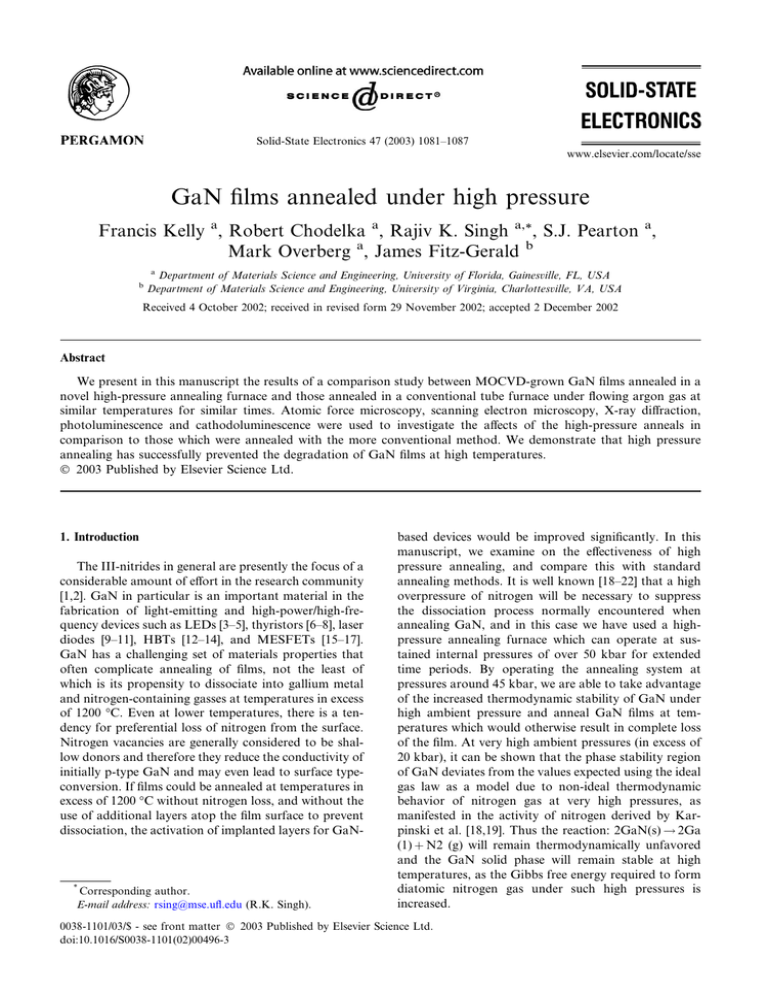
Solid-State Electronics 47 (2003) 1081–1087 www.elsevier.com/locate/sse GaN films annealed under high pressure Francis Kelly a, Robert Chodelka a, Rajiv K. Singh a,*, S.J. Pearton a, Mark Overberg a, James Fitz-Gerald b b a Department of Materials Science and Engineering, University of Florida, Gainesville, FL, USA Department of Materials Science and Engineering, University of Virginia, Charlottesville, VA, USA Received 4 October 2002; received in revised form 29 November 2002; accepted 2 December 2002 Abstract We present in this manuscript the results of a comparison study between MOCVD-grown GaN films annealed in a novel high-pressure annealing furnace and those annealed in a conventional tube furnace under flowing argon gas at similar temperatures for similar times. Atomic force microscopy, scanning electron microscopy, X-ray diffraction, photoluminescence and cathodoluminescence were used to investigate the affects of the high-pressure anneals in comparison to those which were annealed with the more conventional method. We demonstrate that high pressure annealing has successfully prevented the degradation of GaN films at high temperatures. Ó 2003 Published by Elsevier Science Ltd. 1. Introduction The III-nitrides in general are presently the focus of a considerable amount of effort in the research community [1,2]. GaN in particular is an important material in the fabrication of light-emitting and high-power/high-frequency devices such as LEDs [3–5], thyristors [6–8], laser diodes [9–11], HBTs [12–14], and MESFETs [15–17]. GaN has a challenging set of materials properties that often complicate annealing of films, not the least of which is its propensity to dissociate into gallium metal and nitrogen-containing gasses at temperatures in excess of 1200 °C. Even at lower temperatures, there is a tendency for preferential loss of nitrogen from the surface. Nitrogen vacancies are generally considered to be shallow donors and therefore they reduce the conductivity of initially p-type GaN and may even lead to surface typeconversion. If films could be annealed at temperatures in excess of 1200 °C without nitrogen loss, and without the use of additional layers atop the film surface to prevent dissociation, the activation of implanted layers for GaN- * Corresponding author. E-mail address: rsing@mse.ufl.edu (R.K. Singh). based devices would be improved significantly. In this manuscript, we examine on the effectiveness of high pressure annealing, and compare this with standard annealing methods. It is well known [18–22] that a high overpressure of nitrogen will be necessary to suppress the dissociation process normally encountered when annealing GaN, and in this case we have used a highpressure annealing furnace which can operate at sustained internal pressures of over 50 kbar for extended time periods. By operating the annealing system at pressures around 45 kbar, we are able to take advantage of the increased thermodynamic stability of GaN under high ambient pressure and anneal GaN films at temperatures which would otherwise result in complete loss of the film. At very high ambient pressures (in excess of 20 kbar), it can be shown that the phase stability region of GaN deviates from the values expected using the ideal gas law as a model due to non-ideal thermodynamic behavior of nitrogen gas at very high pressures, as manifested in the activity of nitrogen derived by Karpinski et al. [18,19]. Thus the reaction: 2GaN(s) ! 2Ga (1) þ N2 (g) will remain thermodynamically unfavored and the GaN solid phase will remain stable at high temperatures, as the Gibbs free energy required to form diatomic nitrogen gas under such high pressures is increased. 0038-1101/03/$ - see front matter Ó 2003 Published by Elsevier Science Ltd. doi:10.1016/S0038-1101(02)00496-3 1082 F. Kelly et al. / Solid-State Electronics 47 (2003) 1081–1087 2. Experimental The furnace used for the high-pressure anneals was originally designed in Novosibirsk, Siberia, Russia for the purposes of growing gem-quality synthetic diamonds. The machine, shown schematically in Fig. 1, consists of a large four-part steel outer shell inside of which is a pair of hemispherical gaskets. Hydraulic fluid is pumped into the shell and used to pressurize the system. Inside of the gaskets is a set of eight octant-shaped metal dies, which, when assembled, forms a spherical pressuretransducer. Inside the spherical pressure transducer is a octahedral cavity into which goes a second set of smaller metal dies which in turn form a second pressure transducing assembly which has a small rectangular cavity at its center, and therefore at the center of the spherical furnace system. This small rectangular cavity houses a core cell that is composed of as many as 20 individual parts, including the sample to be annealed. The core cell is assembled from ceramic, metal, and graphite components in the laboratory, loaded into the pressure transducer for annealing and is destroyed upon recovery of the samples. The core cells were constructed and then placed in a Forma Scientific vacuum oven at 140 °C for 24 h to eliminate any moisture prior to being loaded in the highpressure system. The pressure system was then purged with dry nitrogen (99.99 pure) for 120 s to force out as much ambient air as possible before pressurization. After the high-pressure system reached the desired pressure, in this case 45 2 kbar, an AC current was then applied to the graphite heating element inside the cell. The slope of this line was calibrated and the power set to the temperatures of interest in each case. The power was ramped manually by adjusting the heater voltage and the average ramp rate was kept around 10 °C/min. To compare the effects of high pressure annealing with that of standard furnace anneals, the furnaceannealed samples were cleaved from the wafer, cleaned in methanol, allowed to dry in the laboratory, and loaded into a digitally controlled Lindberg tube furnace with an alumina sample tube. The air in the tube was first flushed out with argon and then the anneals were carried out in the hot zone of the furnace under a 10 ml/min continuous flow of argon for the same times and temperature as the high-pressure samples. The temperature was ramped up to the desired temperature at a ramp rate of 10 °C/min, controlled by the digital furnace controller. Each sample was mounted into a Phillips XÕPert highresolution X-ray diffractometer and X-ray diffraction scans were carried out to detect any phases that may have formed or disappeared as a result of the annealing process. All but one of the scans revealed a peak at 34.5° which is associated to the well-known (0 0 0 2) reflection of GaN. The sample annealed in flowing argon at 1300 °C, shown in showed no such GaN (0 0 0 2) peak. Auger electron spectroscopy data performed on this sample revealed only aluminum and oxygen, whereas similar characterization of the other samples revealed gallium and nitrogen. Atomic force microscopy (AFM) was performed on these samples using a Nanoscope III system. Three representative areas were selected on each sample using the deviceÕs optical system and those areas were probed in AFM surface tapping mode. The Nanoscope III software then analyzed the resulting topograph of the Fig. 1. Cross-section view schematic of the high pressure transducer system used for high pressure annealing. F. Kelly et al. / Solid-State Electronics 47 (2003) 1081–1087 surface and calculated a mean square roughness value (RMS) for each probed area. 3. Results and discussion Fig. 2 shows two AFM scans from two samples annealed at 1100 °C, one under high pressure, and the other in the conventional tube furnace. The surface morphology from the former is clearly superior and indicates that the high pressure approach is capable of suppressing loss of nitrogen from the surface at this temperature. Average RMS values for each sample were plotted in Fig. 3 as a function of annealing temperature. Note the severe increase in surface roughness for anneals above 900 °C in the tube furnace, compared to the much smaller changes 1083 recorded for the high pressure annealing. The AFM comparison graph in Fig. 3 shows no data point for the furnace-annealed sample at 1300 °C, as it was earlier determined that that sample had no film remaining on it at all, and, as such, the roughness measured would have been from the bare substrate material alone. It can be clearly seen that, for the 1 1 lm2 square areas probed by the AFM, the samples annealed under high pressure were generally of higher surface quality than those annealed in the conventional furnace. The high-pressureannealed samples all had RMS values of less than 10 nm, and the samples annealed at higher than 1000 °C in the furnace were more than 20 as rough as the high-pressure-annealed samples. The samples were then scanned in the Phillips XÕPert high resolution diffractometer and all but one of the Fig. 2. A pair of AFM scans taken from (a) the sample annealed at 1100 °C under high pressure and (b) the sample annealed at 1100 °C in flowing argon. Note the vertical scales are different for the two scans. 1084 F. Kelly et al. / Solid-State Electronics 47 (2003) 1081–1087 Fig. 3. Comparison graph of film roughness versus anneal temperature. The dashed line represents the samples annealed in flowing argon, the solid line represents those annealed under high pressure. Fig. 4. Rocking curves for the high-pressure annealed GaN films. scans revealed a peak at 34.5° which is associated to the well-known (0 0 0 2) reflection of GaN. The sample annealed in flowing argon at 1300 °C showed no such GaN (0 0 0 2) peak. Auger electron spectroscopy data performed on this sample revealed only aluminum and oxygen, whereas similar characterization of the other samples revealed gallium and nitrogen. High resolution x 2h X-ray scans were also recorded for each sample to investigate any changes in lattice parameter of the GaN films upon annealing. The resulting curves taken from the high-pressure annealed samples are shown superimposed in one plot in Fig. 4, and the corresponding curves for the samples annealed in flowing argon in Fig. 5. These data were then analyzed in the PhillipÕs XÕPert software and a full width at half maximum (FWHM) was extracted for each rocking curve. These FWHM values are compiled and plotted versus temperature in Fig. 6. As shown by the rocking curve data, the furnace-annealed samples seem to be of higher quality than the high-pressure-annealed samples at low temperatures, but the slopes of the two trend lines indicate that the FWHM at temperatures above F. Kelly et al. / Solid-State Electronics 47 (2003) 1081–1087 1085 Fig. 5. Rocking curves taken from the samples annealed in flowing argon. Fig. 6. Comparison plot of FWHM versus temperature for the two annealing processes. The solid line represents the high-pressure process, and the dashed line represents the flowing argon process. 1300 °C will tend to be lower for the high-pressure samples. Cathodoluminescence data taken from the sample annealed under high-pressure at 1300 °C is shown in Fig. 7. The band edge emission at 3.4 eV can clearly be seen, as can a yellow emission feature near 2.2 eV. Given the proximity of the sample to the graphite heating element in the high-pressure system, this yellow peak is most likely due to the diffusion of carbon impurities into the film during the annealing process, which would, to some extent, account for the increase in FWHM of the high-pressure sample high resolution x 2h curves as well. Substitutional carbon defects on the nitrogen sublattice would not likely lead to a large increase in FWHM of the x 2h X-ray scans, as the atomic radii of nitrogen and carbon are fairly close to each other. Substitutional carbon on the gallium sublattice, however, should lead to increased FWHM of those scans, since the gallium atom is much larger than the carbon atom. This is supported by the 1086 F. Kelly et al. / Solid-State Electronics 47 (2003) 1081–1087 Fig. 7. Cathodoluminescence spectrum of the sample annealed under high pressure at 1300 °C. Fig. 8. Photoluminescence spectrum taken at 50 K of the sample annealed under high pressure at 1100 °C. photoluminescence spectra, as there are prominent band edge and yellow emission signals from the sample annealed at 1100 °C under high pressure, as can be seen in Fig. 8. The furnace annealed samples, which were not annealed is such close proximity to any carbon source do not show the increased FWHM in their X-ray scans. 4. Conclusions While the data presented herein clearly show that the high pressure process has been successful in suppressing the tendency of GaN to dissociate upon hightemperature annealing, other factors which degrade the GaN films in other ways are also observed to occur. Carbon from the heating element is most likely the cause of the increased yellow emission in the films and also the increase in the FWHM of the X-ray rocking curves. Acknowledgements We would like to thank Mr. Eric Lambers of the Major Analytical Instrumentation Center (M.A.I.C.) at the University of Florida performing Auger spectroscopy of the samples, and Dr. Valentin Craciun for all of his help with the Phillips XÕPert system. We would also like to thank Dr. Reza Abbaschian of the University of Florida as well as Dr. Alexander Novikov and Dr. Nikolay Patrin of the Gemesis Corporation for their expertise with the high pressure system. The work at UF is partially supported by NSF DMR 01001438. References [1] Pearton SJ, Ren F, Zhang AP, Lee KP. Mater Sci Eng R 2000;30:55–212. [2] Pearton SJ, Zolper JC, Shul RJ, Ren F. Appl Phys Rev 1999;86:1–78. F. Kelly et al. / Solid-State Electronics 47 (2003) 1081–1087 [3] Szweda R. III–VÕs Rev 1997;10:20–5. [4] Harle V, Hahn B, Lugauer H-J, Bader S, Bruderl G, Baur J, et al. Phys Stat Sol 2000;180:5–13. [5] Oda O, Inoue T, Seki Y, Kainosho K, Yaegashi S, Wakahara A, et al. Phys Stat Sol 2000;180:51–8. [6] Bandic ZZ, Bridger PM, Piquette EC, McGill TC. SolidState Electron 2000;44:221–8. [7] Bandic ZZ, Piquette EC, Bridger PM, Beach RA, Kuetch TF, McGill TC. Solid-State Electron 1998;42:2289–94. [8] Cao XA, Pearton SJ, Donovan SM, Abernathy CR, Ren F, Zolper JC, et al. Mater Sci Eng B 1999;59:362–5. [9] Bour DP, Kneissl M, Van De Walle GG, Northrup J, Romano LT, Teepe M, et al. Phys Stat Sol 2000;180: 139. [10] Bader S, Hahn B, Lugauer H-J, Lell A, Weimar A, Bruderl G, et al. Phys Stat Sol 2000;180:177. [11] Ambe C, Takeuchi T, Katoh H, Isomura K, Satoh T, Mizumoto R, et al. Mater Sci Eng B 1999;59:382–5. [12] Asbeck PM, Yu ET, Lau SS, Sun W, Dang X, Shi C. SolidState Electron 2000;44:211–9. 1087 [13] Ren F, Han J, Hickman R, Van Hove JM, Chow PP, Klaassen JJ, et al. Solid-State Electron 2000;44:239–44. [14] McCarthy LS, Smorchkova IP, Xing H, Kozodoy P, Fini P, Limb J, et al. IEEE Trans Electron Dev 2001;48:543–51. [15] Lee C, Lu W, Piner E, Adesida I. Solid-State Electron 2002;46:743–6. [16] Boudart B, Gaquiere C, Guhel Y, de Jaeger JC, Poisson MA. Elecron Lett 2001;37:1–2. [17] Polyakov VM, Schwierz F. IEEE Trans Electron Dev 2001;48:512–6. [18] Van Vechten JA. Phys Rev B 1973;7:1479–507. [19] Porowski S. Mater Sci Eng B 1997;44:407–13. [20] Cao XA, LaRoche JR, Ren F, Pearton SJ, Lothian JR, Singh RK, Wilson RG, Guo HJ, Pennycook SJ. SolidState Electronics 1999;43:1235–8. [21] Hong J, Lee JW, Vartuli CB, MacKensie JD, Donovan SM, Abernathy CR, Crockett RV, Pearton SJ, Zolper JC, Ren F. Solid State Electronics 1997;41:681–94. [22] Karpinski J, Jun J, Porowski S. J Crystal Growth 1984; 66:1–10.
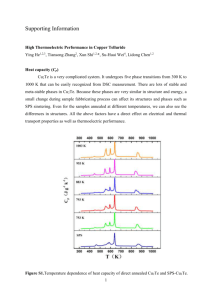

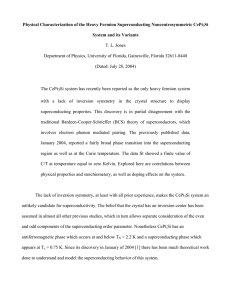

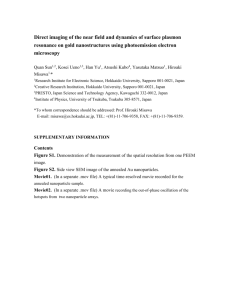
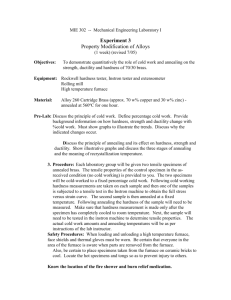
![Structural and electronic properties of GaN [001] nanowires by using](http://s3.studylib.net/store/data/007592263_2-097e6f635887ae5b303613d8f900ab21-300x300.png)